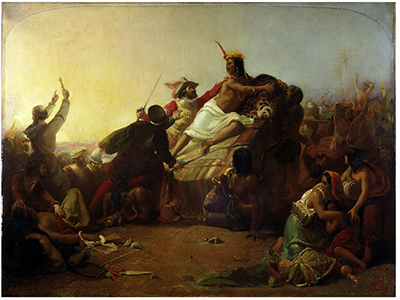The Viceroyalty of Peru
Part 1: Conquest and Administration The Viceroyalty of Peru was the largest of Spain's four such political arrangements in the New World, at its height encompassing all or part of what is now Argentina, Bolivia, Chile, Colombia, Ecuador, Panama, Paraguay, Uruguay, and Venezuela. Spanish ruled over this area from 1542 to 1824. 
The Spanish conquistador Francisco Pizarro arrived in Inca lands in 1532, the same year that Atahualpa emerged from a deadly civil war and claimed the Inca throne. Pizarro and his force of armed men had arrived with the intention of conquering the Inca while also spreading Christianity.
The two leaders arrived at a meeting. Both brought a retinue. After a misunderstanding, Pizarro gave the order to attack. The number of Inca dead that day exceeded 2,000. Pizarro ordered Atahualpa captured. The Inca ruler offered a large amount of gold and silver as a ransom. Pizarro accepted the precious metals but then refused to release his prisoner. He ordered Atahualpa kept hostage for a few months and then, on Aug. 29, 1533, ordered him killed, directly after giving him a Christian baptism. Pizarro and his men had also arrived at a time in which Inca people by the hundreds and thousands were dying of smallpox and other killers, brought by European explorers. The combination of the killing efficiency of these diseases and the overwhelming advantage in weaponry that the Spanish sported led to the demise of the Inca Empire. 
Pizarro ordered built what is now Lima, in 1535. While construction of that city continued, the Inca put up a spirited defense. Manco Inca, whom Pizarro had installed as a puppet emperor, revolted and led the resistance, seizing some Spanish territory and centralizing his efforts at what he proclaimed to be a new capital, Vilcabamba. He fought on, meeting his death in 1544. By that time, the Spanish leadership had fragmented. Arriving with Pizarro as one of the leaders of the expedition had been Diego de Almagro. A disagreement between the two led to a parting of the ways and then a severe enmity. Hernando Pizarro, Francisco's brother, killed de Almagro in 1538. Three years later, de Almagro's son killed Francisco Pizarro. Hernando was unable to take advantage because he had been taken prisoner after returning to Spain to lobby the king and queen for support. Inca resistance continued in Vilcabamba for another 30 years, as the Spanish ruled more and more of what had been the Inca Empire. Spanish troops captured the last Inca ruler, Tupac Amaru, in 1572. The last resistance crumbled, the last remaining Inca surrendered, both Vilcabamba and overall, and the Spanish conquest was complete. 
Lima became the administrative center of Spanish-owned Inca lands. In 1542, the Spanish Crown established the Viceroyalty of New Castile, which morphed into the Viceroyalty of Peru. Spain's King Charles I appointed Blasco Núñez Vela as the first viceroy. It was a slightly later viceroy, Francisco Álvarez de Toledo (right), who ended Inca resistance once and for all and set about remaking Inca lands in the Spanish mold. After an extensive tour of the new colony, Toledo introduced a number of reforms and other measures. He reorganized the way in which people lived, adopting the reduccion system that resulted in the forced relocation of thousands of indigenous people, so that they could more easily be taxed and converted to Christianity. He instituted the Inquisition but not on the scale of what had been done in Spain. The tax was high and delineated by social class. The Spanish established more than 800 of these settlements.
Toledo also introduced the mita, a system of forced labor, in order to work the network of mercury and silver mines that powered the Spanish economy for decades. Serving for 12 years, Toledo had a powerful impact on the South American landscape. (Of the 55 who eventually served as viceroy, Toledo was not the longest-serving. Two viceroys served for 16 years: Melchor Portocarrero (1689–1705) and José Antonio de Mendoza (1745–1761).)  Next page > From Spanish Imprint to Independent Territories > Page 1, 2 |
|
Social Studies for Kids
copyright 2002–2025
David White




